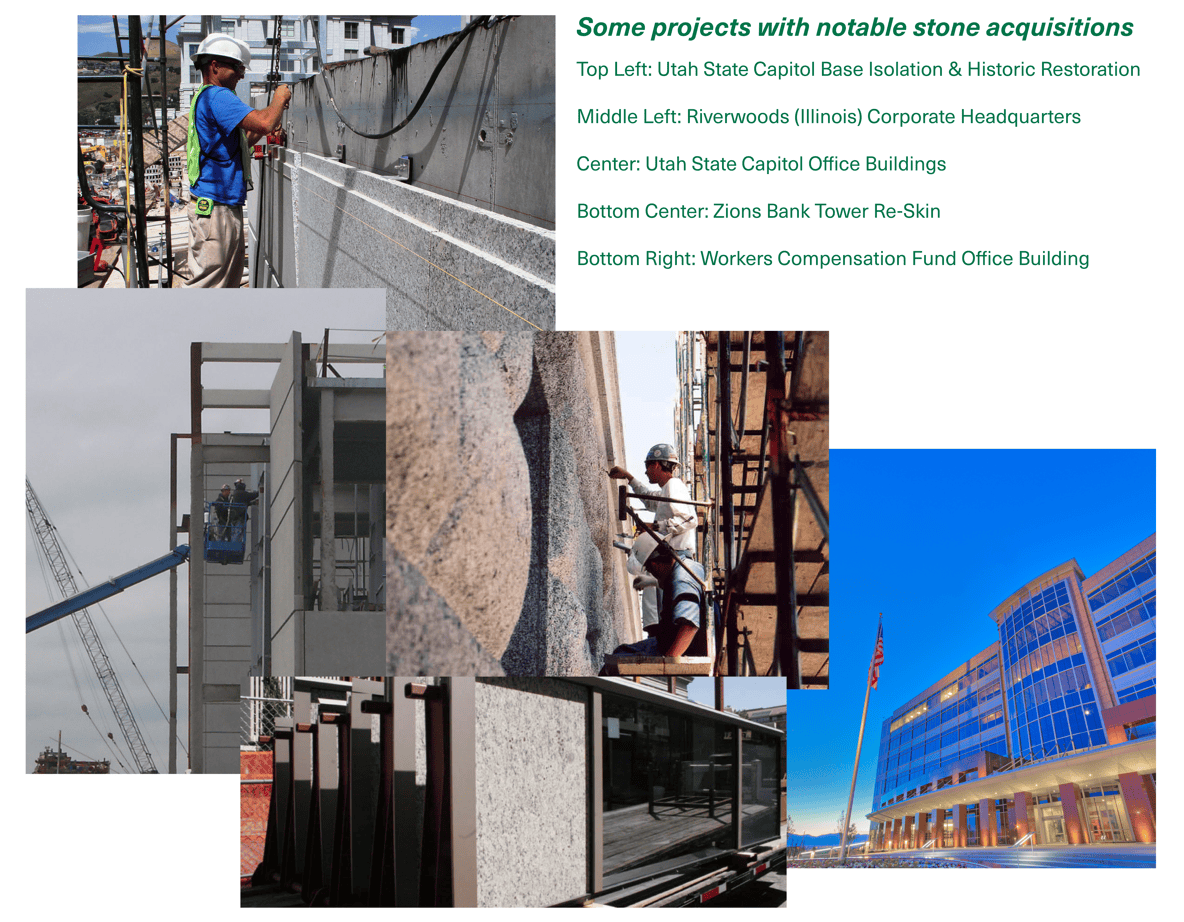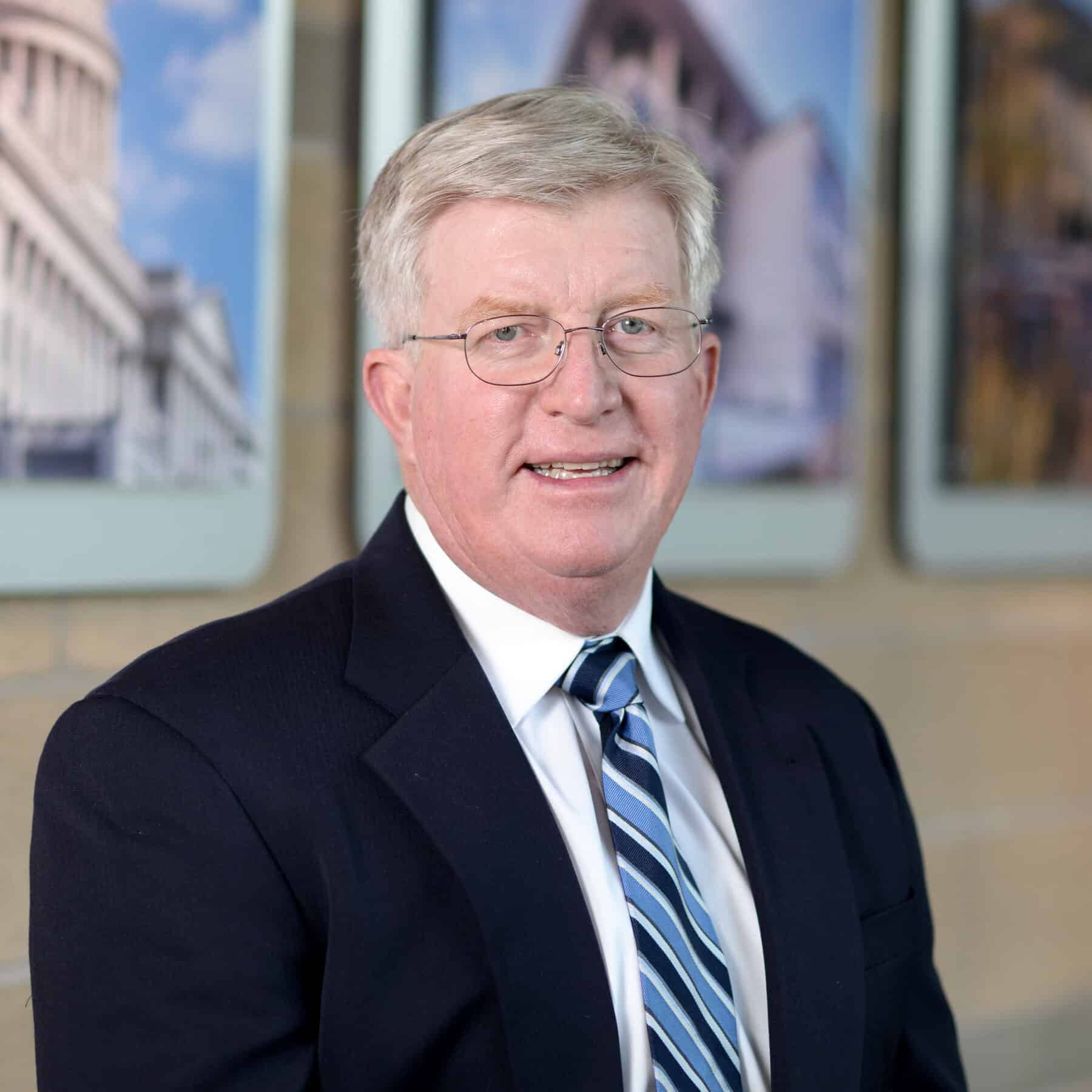Share
SALT LAKE CITY — The last place in the world to review the quality of stone, according to Terry Wright, is the jobsite.
“If you decide you don’t like it when it arrives at the project, that’s about six months too late,” Wright says.
The bated breath of each project owner that accompanies every marble delivery or granite shipment, then, is understandable — and the moment of its arrival is pivotal in shaping how a client will perceive the success and quality of their project. That’s why, in a big step forward for Jacobsen’s coming of age as a contractor, Wright spearheaded efforts to scour the world for the best quarries — and supplier relationships — that could be found anywhere.
“We had to make some commitments as to how we could take our project quality to a new level. And Jacobsen decided that a big part of that needed to be to reach out to fabricators — not just installers — and develop a rapport with them,” said Wright, who retired in 2020 from a storied 38-year Jacobsen career as a project executive, project manager, project superintendent and estimator.
Once Jacobsen made this strategic shift for stone procurement, the company was all in. Beginning in the late 1980s, Wright spent thousands of days and nights traveling the world in search of the best stone at the best prices.
“I engaged with numerous types of quarries because not all of them do marble and not all of them had access to other types of stone we were interested in,” Wright said. “We knew we couldn’t eat the whole elephant with a small number of quarries.”
Curating a thorough, reliable web of trusted quarry partnerships in several countries was a massive undertaking, particularly in pre-internet times, but Wright began to methodically pick up introductions and develop productive partnerships through face-to-face meetings with suppliers and through networking at key industry conventions.
“It was a lot of work to find the right relationships, but it always paid off,” Wright said. “Even when we didn’t find exactly what we were looking for at a quarry for a specific project, we made note of what they did have and began building up a list of our most trusted and high-quality suppliers.”
Finding the best materials required a good deal of patience. On the Salt Lake Temple Major Renovation, for example, Wright spent 14 months searching for the material that would most faithfully match the temple’s original interior marble that had been procured from a quarry that had since shut down.
“There was a lot of thorough searching on that project to make sure we could make a selection that was exactly right,” he said.
Wright’s adventures took him to countries that are the mainstays of exported marble, limestone, granite, quartzite and sandstone, including Italy, Spain, Portugal, Brazil and China. But he also traveled throughout the United States and found a growing number of promising stone suppliers in international markets such as Mexico, India, Egypt, Norway, Sweden and Finland. The diverse set of destinations offered a crash course in how differently business is done in other regions of the world, he said.
“The differences of expectations in other countries about schedules, contracts and other elements of dealmaking meant we had to develop unique ways to not only convey what we needed but create the right enforcement mechanisms to make sure we could meet project expectations,” Wright said. “That was always part of our due diligence — to work out how our two entities could overcome any barriers and work together so that both sides were satisfied with the process.”
Foreign trips often included little sleep, in order to pack in as many quarry visits as possible.
“I’d do much better at relaxing on the flight back, with the work done,” Wright recalled.
So, how many times exactly has Wright circled the globe? To be honest, he said, he’s lost track.
“Let’s put it this way — I racked up about 2 million airline miles,” he said with a laugh.
Within just a few years, Wright said, the process of scouting quarries grew in sophistication, and Jacobsen established a reputation as the preeminent general contractor in Utah for stone sourcing, with an unequaled talent for finding and selecting rare and high-quality stone with specially chosen aesthetic qualities that could check every box on owners’ wish lists. Adding that type of decisive advantage to Jacobsen’s already strong reputation for innovative methods and strong owner relationships, he said, accelerated Jacobsen’s growth as a company and set it on a path to win ever larger and more complex projects for marquee clients in the 1990s and beyond. As project owners and design teams began to take notice of the quality of stone that Wright was able to procure through his diligent research and travel, they even started to join him on his trips so they could see different options for themselves and narrow down their preferences on the spot.
“We started working more closely with design teams and project owners in taking really specific recommendations or requests for very specific types of looks, and identifying different materials and thicknesses that would meet the aesthetic they were aiming for,” Wright said.
In addition to the still-ongoing Salt Lake Temple Major Renovation, a few outstanding marble projects stand out especially powerfully in Wright’s memory: the Zions Bank Tower re-skin (2006), the Utah Worker’s Compensation Fund Building (2010), the Riverwoods Corporate Headquarters campus in Illinois (2003), as well as the base isolation and historical restoration of the Utah State Capitol Building (2007) and construction of office buildings on the Utah State Capitol campus (2009). These and other undertakings strengthened Jacobsen’s reputation as a market leader in quality craftsmanship on projects that emphasized a stone aesthetic.
“We learned we were getting high marks this way. Sometimes the feedback we got was — ‘you guys make this look so easy,’ and more frequently we wouldn’t have any punchlist requests or very few,” Wright said. “It felt good to know there was a noticeable improvement as a result of these many trips.”
Because of Jacobsen’s added stone capabilities, Utah clients in the past three decades have been able to re-imagine what is possible for the look of their projects, leading to them deepening their ties with the company with the assurance that no stone request, given enough due diligence, would be beyond Jacobsen’s capabilities. Wright welcomed those heightened expectations with open arms.
“Because especially well-sourced stone can be a significant part of a project’s budget, our project owners have really set that expectation of high quality, understanding what we’re capable of. And that’s a good thing, we want them to anticipate a great look and great results when working with Jacobsen, and to know we can make it happen,” he said.
Finding the perfect project match for a meticulously examined stone quarry is a one-of-a-kind gratifying moment, Wright said, and can take years to come to fruition.
“There are lots of materials that I would see and think that there may one day be a use for that, so I’d file it away,” he said. “And one day I would be having a conversation with a project owner, and could say — ‘oh yeah, I saw something just like that five years ago.’ And that’s a great feeling.”
A great feeling — that’s what Jacobsen has sought to give to project owners, as the underlying goal and ultimate motivator of the company’s rigorous stone procurement efforts over the years. When an owner can feel good and rest easy, knowing the best stone available was used to give their project its own unique look, that is the moment that validates all the worldwide searching as an investment well worth the time and effort, according to Wright. And every time a Jacobsen building has been completed over the last 30-plus years, he said, its clients have been able to unfailingly rely on these unique edifices of stone — these marble marvels and towering assemblies of granite — to successfully encapsulate the most magnificent natural beauty found anywhere in the world and showcase it in the places where life happens, where people go to be together, and where lasting communities take shape.


